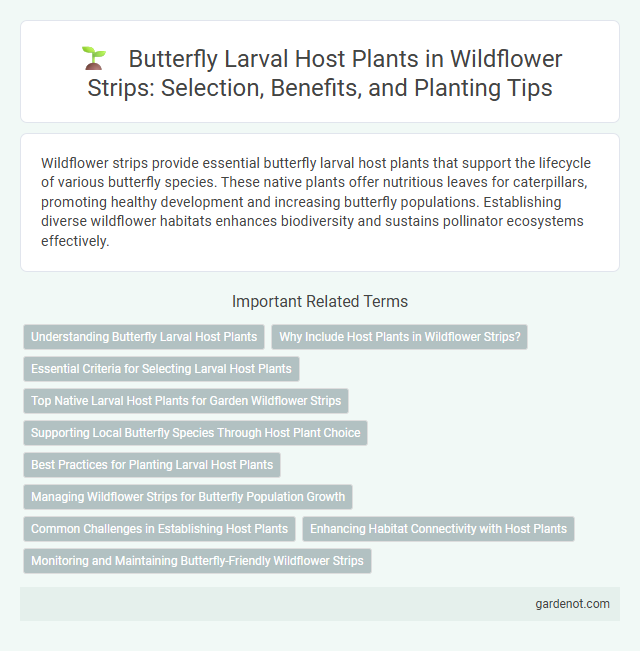Wildflower strips provide essential butterfly larval host plants that support the lifecycle of various butterfly species. These native plants offer nutritious leaves for caterpillars, promoting healthy development and increasing butterfly populations. Establishing diverse wildflower habitats enhances biodiversity and sustains pollinator ecosystems effectively.
Understanding Butterfly Larval Host Plants
Butterfly larval host plants are essential for the survival and development of butterfly larvae, providing necessary nutrients for growth. Selecting native wildflower species like milkweed, fennel, and violets supports specific butterfly species by offering suitable leaves for egg-laying and caterpillar feeding. Understanding these host plant relationships enhances biodiversity and promotes successful butterfly populations in wildflower strips.
Why Include Host Plants in Wildflower Strips?
Including butterfly larval host plants in wildflower strips supports vital stages of butterfly life cycles, enhancing biodiversity and ecosystem health. These host plants provide essential food sources for caterpillars, increasing larval survival rates and promoting stable butterfly populations. Integrating native host plants also attracts diverse butterfly species, contributing to pollination and ecological balance.
Essential Criteria for Selecting Larval Host Plants
Selecting butterfly larval host plants requires prioritizing native species that provide adequate nutrition and habitat for caterpillar development, as these plants support higher survival rates and butterfly biodiversity. Essential criteria include plant species' compatibility with local butterfly larvae, seasonal availability to match larval feeding periods, and non-toxicity to ensure larvae health. Incorporating a diverse range of host plants tailored to target butterfly species enhances ecological balance and promotes successful butterfly reproduction in wildflower strips.
Top Native Larval Host Plants for Garden Wildflower Strips
Top native larval host plants for garden wildflower strips include milkweed (Asclepias spp.), essential for monarch butterfly caterpillars, and violet species (Viola spp.), which support fritillary larvae. Passionflower vines (Passiflora incarnata) provide crucial habitat for Gulf fritillary and zebra longwing butterflies. Incorporating these native plants enhances butterfly breeding success and biodiversity in wildflower strips.
Supporting Local Butterfly Species Through Host Plant Choice
Selecting native wildflower strips with specific butterfly larval host plants like milkweed, goldenrod, and violets directly supports local butterfly species by providing essential resources for caterpillar development. These host plants ensure higher larval survival rates and contribute to the biodiversity of pollinators in the area. Incorporating a diverse range of native species tailored to regional butterflies strengthens ecosystem resilience and promotes sustainable habitat connectivity.
Best Practices for Planting Larval Host Plants
Plant native butterfly larval host plants in well-prepared soil with full to partial sunlight, ensuring varied species to support diverse butterfly populations. Space plants appropriately to allow airflow and reduce disease, and water consistently during establishment while avoiding overwatering that can lead to root rot. Incorporate organic mulch to retain moisture and suppress weeds, and minimize pesticide use to protect sensitive larvae and encourage healthy butterfly development.
Managing Wildflower Strips for Butterfly Population Growth
Managing wildflower strips by planting native butterfly larval host plants such as milkweed, violet species, and parsley supports essential habitats for butterfly larvae to thrive. Maintaining diverse plant species, avoiding pesticides, and ensuring seasonal plant availability enhances larval survival and boosts butterfly population growth. Regular monitoring and adaptive mowing schedules preserve host plant health and promote successful butterfly reproduction in wildflower ecosystems.
Common Challenges in Establishing Host Plants
Establishing butterfly larval host plants in wildflower strips often faces challenges such as soil incompatibility, which affects plant survival and growth. Invasive species can outcompete native host plants, reducing the available habitat for butterfly larvae. Limited seed availability and improper planting techniques further hinder successful establishment and long-term persistence of host plants.
Enhancing Habitat Connectivity with Host Plants
Butterfly larval host plants in wildflower strips play a critical role in enhancing habitat connectivity by providing essential resources for caterpillar development and supporting butterfly population dispersal across fragmented landscapes. Incorporating native host plants such as milkweed, violets, and goldenrod in strategic arrangements facilitates movement corridors, promoting genetic diversity and resilience in butterfly communities. Effective habitat connectivity through these larval hosts ensures sustained pollination services and biodiversity conservation in agricultural and urban ecosystems.
Monitoring and Maintaining Butterfly-Friendly Wildflower Strips
Monitoring butterfly larval host plants in wildflower strips involves regular inspection for eggs, caterpillars, and larval feeding signs on species such as milkweed, violet, and parsley. Maintaining butterfly-friendly wildflower strips requires removing invasive weeds, ensuring diverse native plant species, and avoiding the use of pesticides that harm larvae. Consistent habitat management supports successful metamorphosis and sustainability of butterfly populations by providing essential resources throughout their life cycle.
Butterfly larval host Infographic

 gardenot.com
gardenot.com